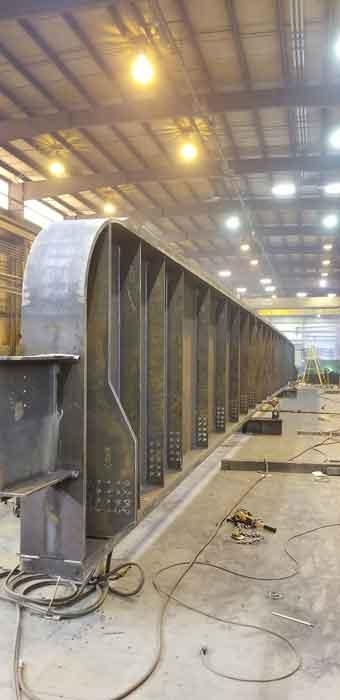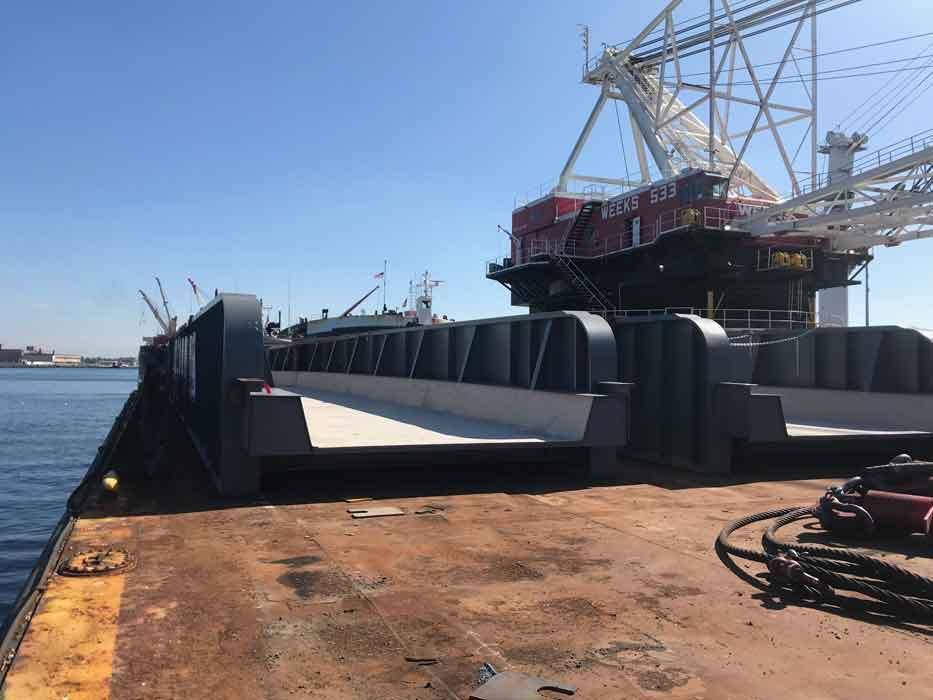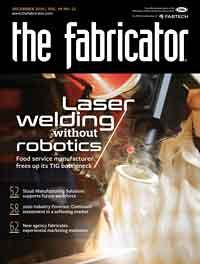Senior Editor
- FMA
- The Fabricator
- FABTECH
- Canadian Metalworking
Categories
- Additive Manufacturing
- Aluminum Welding
- Arc Welding
- Assembly and Joining
- Automation and Robotics
- Bending and Forming
- Consumables
- Cutting and Weld Prep
- Electric Vehicles
- En Español
- Finishing
- Hydroforming
- Laser Cutting
- Laser Welding
- Machining
- Manufacturing Software
- Materials Handling
- Metals/Materials
- Oxyfuel Cutting
- Plasma Cutting
- Power Tools
- Punching and Other Holemaking
- Roll Forming
- Safety
- Sawing
- Shearing
- Shop Management
- Testing and Measuring
- Tube and Pipe Fabrication
- Tube and Pipe Production
- Waterjet Cutting
Industry Directory
Webcasts
Podcasts
FAB 40
Advertise
Subscribe
Account Login
Search
In-house bridge fabrication taken to the extreme
Greiner Industries shows the potential of in-house fabrication, welding
- By Tim Heston
- December 10, 2019
- Article
- Materials Handling

Greiner welders perform final shop welding for an unusual railroad bridge—fully assembled in-house and designed to be shipped as a single piece.
In early fall a barge churned quietly east along Long Island Sound, carrying what anyone in structural bridge fabrication would consider a modern marvel. Being carried were two 19-foot- wide, 118-ft.-long railroad bridges, not in pieces but fully bolted, welded, and painted. The two complete units—each more than 340,000 pounds, or 170 tons—were headed to a harbor on the north side of Long Island’s southern fork, where they would be offloaded and trucked at night to their destination near East Hampton.
Long Island Railroad, which operates one of the busiest commuter rails in the country, needed to replace two aging bridges, but it couldn’t afford a prolonged disruption. Even more challenging, the locations of the two identical bridge spans, each several miles apart on the same railroad line, left little room for a construction site.
“It’s a brief shutdown period. Within weeks, they’re removing two existing bridges, raising the grade of the track, and installing two new bridges, all in the same shutdown period.”
That was Kevin Benner, project manager for Greiner Industries, a heavy fabricator in Mount Joy, Pa., with a long reputation for large-scale fabrication. But this bridge project tread into new territory, even for Greiner.
“We can move a lot of heavy things,” said Frank Greiner, company founder and president. “We have a 600-ton hydraulic crane, and we’ve been into extremely heavy fabrication for many years. We can handle everything but the hauling.”
It’s the hauling, which Greiner subcontracted to New York-based Bay Crane, that made this approach to bridge fabrication possible. The project called for specially built tractor-trailers, imported from Germany, which would truck the two “whole” bridges from Mount Joy to Newark, N.J., offload onto a barge, then pick them up on Long Island’s southern fork and truck them to the job sites.
Better hauling capabilities have presented new structural fabrication challenges, both in building and bridge fabrication, as more work occurs in the controlled shop environment. For this project these challenges arose in two areas. First came the welding challenges, both in terms of heat control and weld access. Second, the job sequencing was absolutely critical.
Fit and Finish
Bridge fabrication practices depend on the job specifications, but typically Greiner’s fab shop cuts, welds, and bolts components to test-fit the assembly, everything from the floor beams and diaphragms to the deck and curb plates. Once everything fits up correctly, components are disassembled, blasted, painted (typically a primer, intermediate, and final coat), and loaded onto trucks for delivery to the job site.
The Long Island job required that bolting and welding typically performed in the field be completed in the shop. That seems straightforward enough. Instead of loading components onto trucks directly after painting, why not simply add a “final” bolting and welding step?
It wasn’t that simple. Because these bridges had to leave Greiner fully painted and cosmetically pristine, final painting couldn’t occur until after final welding and bolting. Specs also required every nut, bolt, and thread showing on the surface to be blasted in position, when fully assembled.
Greiner has a blast and painting facility with bridge cranes that can handle up to 100 tons, but fully assembled, these bridges weighed much more than that. And even if the facility could handle such a heavy structure, transporting the fully assembled bridge would have been extremely time-consuming.
For this massive job, it simply made sense to bring final blasting and painting to the bridges. The company dedicated a significant amount of space in its fabrication department for final fabrication and finishing.
The schedule called for one final, enormous setup in the fab shop. Individual components would receive primer and intermediate coats at the paint facility, then be transported to the main fabrication plant for final alignment, bolting, welding, blasting, and painting.
For areas that required blasting, portable units blasted the bolts and surrounding areas, after which came a primer coat and final welding, then the intermediate coat. After that, the final coat was applied to the entire structure. Greiner’s fabrication plant floor in midsummer looked a little like a secret government lab, with massive plastic sheets hung from above to protect the rest of the shop from blast and paint media.
Final alignment was extremely critical, as was the final fabrication steps. A mistake in final welding would have made for extraordinarily expensive and time-consuming rework. With all the variables at play, the first bridge took a little longer than expected. But Greiner’s planners knew of this possibility and so kept space open in the fab shop to handle the second bridge when it arrived from the painting facility.
“We made sure that space was available,” Benner said, “so everything went very smoothly. And we did all our painting on the off shifts, so we had no other fabrication going on.”
The Deck and Efficient Preheating
The railroad bridges’ deck plates—where the railroad ties sit—are between 0.75 and 1.25 inch thick. “For smaller fabrications, we usually tack things in position and then turn them,” Greiner said. After all, more employees at the company are qualified to weld in the flat position. “But we couldn’t turn this piece and weld it in the flat. It was just too massive.”
Conventionally, the shop turns workpieces with weld positioners or with a series of four lifting trolleys from two 70-ton overhead cranes, with an overall capacity of 140 tons—but this, again, weighed more than 140 tons. “So we had a large number of multipass overhead welds that had to be done,” Greiner said, “many of them stringer beads more than 15 feet long.”
“We talked to our qualified welders,” Benner said, “to understand what they felt would be a good height to position the bridge for welding. They used sliding crawlers on wheels, as you do when working under a car. Unfortunately, we couldn’t jack the bridges up high enough so that everyone could stand up comfortably.”
To get the job done, welders of course took frequent breaks. At this point the deck had been bolted, so weld shrinkage and other heat-related problems weren’t a concern as workers gradually laid down multiple 15-ft.-long weld beads.
The same couldn’t be said, however, for the main girder fabrication, several manufacturing steps upstream. There, multipass subarc welding connected the 4-in. flange splices to the ¾-in.-thick web sections with double-sided bevel groove geometries that required complete joint penetration. All of these welds were fracture-critical, requiring preheat of 350 degrees.
Early on in the project, welders and helpers did what they always have done in such situations: Helpers used large rosebud torches to preheat sections before the subarc system laid down welds, working together with a team on the other side of the girder that was welding the opposite flange.
Of course, helpers with preheating torches couldn’t simply walk ahead of the subarc systems. To achieve the necessary preheat took hours, and everyone kept fighting the heat loss pervasive in such large workpieces being fabricated in the middle of winter. “For each weld we had at least four people with huge rosebud torches,” Greiner said. “It took a huge amount of gas, and they had to start hours before welding.”
As the project progressed, Greiner decided to invest in not one but two induction heating blankets—and not conventional ones that cover a small area, like a pipe circumference, but two blankets large enough to cover both the upper and lower flanges of a 118-ft. girder.
“When you weld a bridge girder like this, you lay it on its side and weld both top and bottom flanges at the same time,” Benner said. “So we essentially had a double induction heating blanket unit.”
Why purchase a blanket that covers the entire workpiece? Why not purchase a small blanket and move it where needed? Blame heat dissipation. In such a massive fabrication, if helpers had to move the blankets in-process, heat would have dissipated into the material and into the air, and the welding operation would have had to pause and wait for material to heat sufficiently. That would have mitigated the entire reason for investing in induction preheating.
Installing the blankets, employees hung special attachments with enough cables to feed induction heat throughout the girder’s length. The job involved insulation material between the induction cables and the subarc welding setups to protect the operators.
With the blankets in place, no longer did workers need to arrive in the dead of night and heave large rosebud torches for hours before welding just to achieve necessary preheating and combat heat loss. Before leaving in the evening, the supervisor simply set a timer for the induction blanket to turn on in the middle of the night. And there was no guesswork, either. The blanket preheated the material to 350 degrees F, per the welding procedure specification. By the time welders arrived for the morning shift, they could simply set up the subarc tractor mechanism, check the flux level and other process parameters, and start welding.
To the Sound
In October several trucks, designed and built in Germany, arrived at Greiner. Using heavy-load-moving equipment, Greiner had relocated the bridges to the storage yard and blocked them to the correct height for the trailers to self-load onto the oversized-load vehicles, which subsequently made their way (slowly) to Newark. There, the bridges were loaded onto a barge, which traveled up the East River toward Long Island Sound.
The entire project was years in the making—but you’d never know it, considering how quickly on-site installation occurred. Greiner answered Long Island Railroad’s request for bid in late 2017. Planning and scheduling took months, and in-house fabrication and painting were carefully choreographed through late 2018 and early 2019. All that choreography, though, proved just how far in-house bridge fabrication can go.
About the Author

Tim Heston
2135 Point Blvd
Elgin, IL 60123
815-381-1314
Tim Heston, The Fabricator's senior editor, has covered the metal fabrication industry since 1998, starting his career at the American Welding Society's Welding Journal. Since then he has covered the full range of metal fabrication processes, from stamping, bending, and cutting to grinding and polishing. He joined The Fabricator's staff in October 2007.
subscribe now

The Fabricator is North America's leading magazine for the metal forming and fabricating industry. The magazine delivers the news, technical articles, and case histories that enable fabricators to do their jobs more efficiently. The Fabricator has served the industry since 1970.
start your free subscription- Stay connected from anywhere

Easily access valuable industry resources now with full access to the digital edition of The Fabricator.

Easily access valuable industry resources now with full access to the digital edition of The Welder.

Easily access valuable industry resources now with full access to the digital edition of The Tube and Pipe Journal.
- Podcasting
- Podcast:
- The Fabricator Podcast
- Published:
- 04/30/2024
- Running Time:
- 53:00
Seth Feldman of Iowa-based Wertzbaugher Services joins The Fabricator Podcast to offer his take as a Gen Zer...
- Industry Events
Pipe and Tube Conference
- May 21 - 22, 2024
- Omaha, NE
World-Class Roll Forming Workshop
- June 5 - 6, 2024
- Louisville, KY
Advanced Laser Application Workshop
- June 25 - 27, 2024
- Novi, MI
Precision Press Brake Certificate Course
- July 31 - August 1, 2024
- Elgin,


































